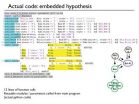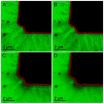(Press-News.org) WASHINGTON D.C. Feb. 19, 2014 -- Life can be messy at all scales, requiring different organizational strategies -- from cleaning the house, to removing damaged or expired cells from the body to avoid cancer progression.
In a messy house, people use computers to manage paper and photo clutter; companies use computer systems to track their inventory. Now a team of researchers at Vanderbilt University in Nashville, Tenn., is taking a similar approach to cell-molecular inventory control for cancer. They have created computer models, using their programming framework (PySB), which enable them to explore the complex biochemical processes that drive cancer growth.
"Our hypothesis is that understanding how the cell uses their protein inventory will lead to understanding why cells dysregulate and become carcinogenic. We expect model outputs will lead to novel, targeted cancer therapies -- possibly by 2019," explained researcher Carlos F. Lopez, who will present the work at the 58th annual Biophysical Society Meeting in San Francisco, Feb.15-19.
Lopez is interested in understanding how cells in multicellular organisms engage programmed cell death -- so-called "cell suicide" -- for cellular removal. It is a natural part of many cells' life cycle.
When cancer cells avoid programmed cell death, uncontrolled growth fuels tumor progression. The Vanderbilt team expects their computer models to identify what goes wrong in these cases, at a speed and scale never before possible. Lopez noted: "We are bridging the nanoscale molecular-level biochemical interactions with the macroscale cancer tumor outcomes, which is a huge range in scales. Most people don't realize this, but molecular chemical reactions at the nanometer and nanosecond level affect things that happen at the timescale level of years -- nine orders of magnitude in space and time! For comparison, a nanosecond is to a second like a second is to one century."
Rather than listing the cellular biochemical reactions by hand, PySB enables the researchers to "write" the biochemical cellular processes as computer programs. "With this approach we can create, simulate, and explore multiple complex mathematical systems that represent biology with ease," Dr. Lopez said.
The models aim to understand how healthy cells normally self-destruct when removal is needed, and why cancer cells avoid the removal signals. If the approach is validated over the next few years, it could lead to the use of predictive mathematical models, representing biochemical signaling processes, to forecast how a cell, group of cells, or a tumor, would respond to single or multiple drug combinations. Targeted, individualized and optimized cancer treatments could then be tailored to each patient.
INFORMATION:
The presentation "PySB: A Modeling Framework to Explore Biochemical Signaling Processes and Cell-decisions" by Carlos F. Lopez and Shawn P. Garbett will be at 1:15 p.m. on Wednesday, February 19, 2014 in Room 304 in San Francisco's Moscone Convention Center. ABSTRACT: http://tinyurl.com/n2nw99a
ABOUT THE MEETING
Each year, the Biophysical Society Annual Meeting brings together more than 7,000 researchers working in the multidisciplinary fields representing biophysics. With more than 4,200 poster presentations, over 200 exhibits, and more than 20 symposia, the BPS Annual Meeting is the largest meeting of biophysicists in the world. Despite its size, the meeting retains its small-meeting flavor through its subgroup symposia, platform sessions, social activities, and committee programs.
The 58th Annual Meeting will be held at the Moscone Convention Center, 747 Howard Street, San Francisco, California.
PRESS REGISTRATION
The Biophysical Society invites professional journalists, freelance science writers and public information officers to attend its Annual Meeting free of charge. For press registration, contact Alisha Yocum at ayocum@biophysics.org or Jason Bardi at 240-535-4954.
QUICK LINKS
Main Meeting Page: http://tinyurl.com/mfjh37p
Program Highlights: http://tinyurl.com/mosxrof
Abstracts Search: http://tinyurl.com/lbrearu
ABOUT THE SOCIETY
The Biophysical Society, founded in 1958, is a professional, scientific Society established to encourage development and dissemination of knowledge in biophysics. The Society promotes growth in this expanding field through its annual meeting, monthly journal, and committee and outreach activities. Its 9000 members are located throughout the U.S. and the world, where they teach and conduct research in colleges, universities, laboratories, government agencies, and industry. For more information on the Society, or the 2014 Annual Meeting, visit http://www.biophysics.org
Clutter cutter
Researchers at the 58th Biophysical Society Meeting in San Francisco Describe using computer modeling to understand how messy cells contribute to cancer
2014-02-19
ELSE PRESS RELEASES FROM THIS DATE:
Does more stress equal more headaches?
2014-02-19
PHILADELPHIA – A new study provides evidence for what many people who experience headache have long suspected—having more stress in your life leads to more headaches. The study released today will be presented at the American Academy of Neurology's 66th Annual Meeting in Philadelphia, April 26 to May 3, 2014.
For the study, 5,159 people age 21 to 71 in the general population were surveyed about their stress levels and headaches four times a year for two years. Participants stated how many headaches they had per month and rated their stress level on a scale of zero to ...
Insurance status may influence transfer decisions in trauma cases, Stanford study reveals
2014-02-19
STANFORD, Calif. — Emergency rooms are less likely to transfer critically injured patients to trauma centers if they have health insurance, according to a new study by researchers at the Stanford University School of Medicine.
The counterintuitive finding suggests that insured patients are more at risk for receiving sub-optimal trauma care than uninsured patients are.
Although a majority of severely injured trauma patients are initially taken to trauma centers, at least one-third are taken to non-trauma centers. In these cases, emergency room doctors must assess the ...
HPV vaccination is associated with reduced risk of cervical lesions in Denmark
2014-02-19
A reduced risk of cervical lesions among Danish girls and women at the population level is associated with use of a quadrivalent HPV vaccine after only six years, according to a new study published February 19 in the Journal of the National Cancer Institute.
Two HPV vaccines are currently available and have proven to be highly effective against HPV16/18-associated cervical cancer. One of these vaccines, a quadrivalent vaccine, was licensed in Denmark in 2006, and it was subsequently incorporated into general childhood vaccination programs for girls free of charge and ...
Whole genome analysis, stat
2014-02-19
Although the time and cost of sequencing an entire human genome has plummeted, analyzing the resulting three billion base pairs of genetic information from a single genome can take many months.
In the journal Bioinformatics, however, a University of Chicago-based team—working with Beagle, one of the world's fastest supercomputers devoted to life sciences—reports that genome analysis can be radically accelerated. This computer, based at Argonne National Laboratory, is able to analyze 240 full genomes in about two days.
"This is a resource that can change patient management ...
Study shows in vivo endomicroscopy improves detection of Barrett's esophagus-related neoplasia
2014-02-19
DOWNERS GROVE, Ill. – February 19, 2014 – New research shows that the addition of confocal laser endomicroscopy to high-definition white-light endoscopy enables improved real-time endoscopic diagnosis of Barrett's esophagus dysplasia (neoplastic tissue) by using targeted biopsies of abnormal mucosa to reduce unnecessary mucosal biopsies and potentially reduce costs. It may also positively influence patient care by changing the plan for immediate endoscopic management. The study appears in the February issue of GIE: Gastrointestinal Endoscopy, the monthly peer-reviewed scientific ...
RXTE reveals the cloudy cores of active galaxies
2014-02-19
VIDEO:
Zoom into the cloudy heart of an active galaxy. This animation shows an artist's rendition of the cloudy structure revealed by a study of data from NASA's Rossi X-Ray Timing...
Click here for more information.
Picture a single cloud large enough to span the solar system from the sun to beyond Pluto's orbit. Now imagine many such clouds orbiting in a vast ring at the heart of a distant galaxy, occasionally dimming the X-ray light produced by the galaxy's monster black ...
NuSTAR helps untangle how stars explode
2014-02-19
For the first time, an international team of astrophysicists, including Lawrence Livermore National Laboratory scientists, have unraveled how stars blow up in supernova explosions.
Using NASA's Nuclear Spectroscopic Telescope Array (NuSTAR) – a high-energy X-ray observatory - the international collaboration created the first-ever map of radioactive material in a supernova remnant, named Cassiopeia A, or Cas A for short. The findings reveal how shock waves likely rip apart massive dying stars, and ultimately end their lives.
A supernova is the cataclysmic death of a ...
REACT clinical trial supports new approach of accelerated treatment for Crohn's disease
2014-02-19
The final results from an international clinical trial involving nearly 2,000 patients with Crohn's disease support the use of a new management strategy referred to as accelerated step-care as a best practice for the care of active Crohn's disease. The REACT (Randomized Evaluation of an Algorithm for Crohn's Treatment) study, led by Robarts Clinical Trials at Western University (London, Canada) provides valuable new insights for community gastroenterologists which should benefit patients. The results of the study will be presented at the European Crohn's and Colitis Organisation ...
ORNL microscopy system delivers real-time view of battery electrochemistry
2014-02-19
OAK RIDGE, Tenn., Feb. 19, 2014 -- Using a new microscopy method, researchers at the Department of Energy's Oak Ridge National Laboratory can image and measure electrochemical processes in batteries in real time and at nanoscale resolution.
Scientists at ORNL used a miniature electrochemical liquid cell that is placed in a transmission electron microscope to study an enigmatic phenomenon in lithium-ion batteries called the solid electrolyte interphase, or SEI, as described in a study published in Chemical Communications.
The SEI is a nanometer-scale film that forms ...
Many Texans struggling to pay for health service as Affordable Care Act is about to launch
2014-02-19
HOUSTON – (Feb. 19, 2014) – Many Texans were struggling to pay for basic health services on the eve of the launch of the Affordable Care Act's Health Insurance Marketplace, according to a report released today by Rice University's Baker Institute for Public Policy and the Episcopal Health Foundation. The report also found that even those with health insurance reported dissatisfaction with the cost and availability of services. Most Texans expect more of the same in 2014.
The Health Reform Monitoring Survey (HRMS)-Texas report is based on the HRMS, a national project that ...
LAST 30 PRESS RELEASES:
Interaction of climate change and human activity and its impact on plant diversity in Qinghai-Tibet plateau
From addressing uncertainty to national strategy: an interpretation of Professor Lim Siong Guan’s views
Clinical trials on AI language model use in digestive healthcare
Scientists improve robotic visual–inertial trajectory localization accuracy using cross-modal interaction and selection techniques
Correlation between cancer cachexia and immune-related adverse events in HCC
Human adipose tissue: a new source for functional organoids
Metro lines double as freight highways during off-peak hours, Beijing study shows
Biomedical functions and applications of nanomaterials in tumor diagnosis and treatment: perspectives from ophthalmic oncology
3D imaging unveils how passivation improves perovskite solar cell performance
Enriching framework Al sites in 8-membered rings of Cu-SSZ-39 zeolite to enhance low-temperature ammonia selective catalytic reduction performance
AI-powered RNA drug development: a new frontier in therapeutics
Decoupling the HOR enhancement on PtRu: Dynamically matching interfacial water to reaction coordinates
Sulfur isn’t poisonous when it synergistically acts with phosphine in olefins hydroformylation
URI researchers uncover molecular mechanisms behind speciation in corals
Chitin based carbon aerogel offers a cleaner way to store thermal energy
Tracing hidden sources of nitrate pollution in rapidly changing rural urban landscapes
Viruses on plastic pollution may quietly accelerate the spread of antibiotic resistance
Three UH Rainbow Babies & Children’s faculty elected to prestigious American Pediatric Society
Tunnel resilience models unveiled to aid post-earthquake recovery
Satellite communication systems: the future of 5G/6G connectivity
Space computing power networks: a new frontier for satellite technologies
Experiments advance potential of protein that makes hydrogen sulfide as a therapeutic target for Alzheimer’s disease
Examining private equity’s role in fertility care
Current Molecular Pharmacology achieves a landmark: real-time CiteScore advances to 7.2
Skeletal muscle epigenetic clocks developed using postmortem tissue from an Asian population
Estimating unemployment rates with social media data
Climate policies can backfire by eroding “green” values, study finds
Too much screen time too soon? A*STAR study links infant screen exposure to brain changes and teen anxiety
Global psychiatry mourns Professor Dan Stein, visionary who transformed mental health science across Africa and beyond
KIST develops eco-friendly palladium recovery technology to safeguard resource security
[Press-News.org] Clutter cutterResearchers at the 58th Biophysical Society Meeting in San Francisco Describe using computer modeling to understand how messy cells contribute to cancer




